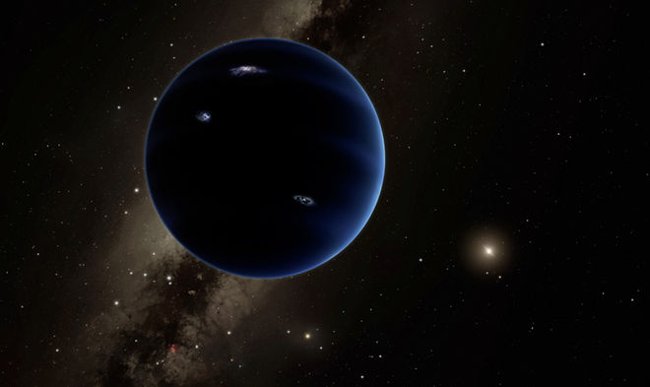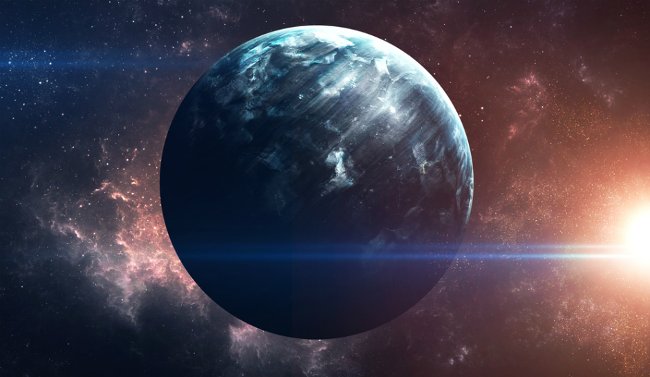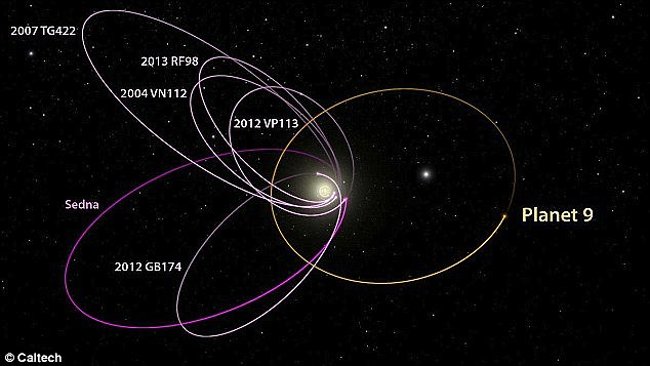The mysterious 9th planet could be a 'free floating' planet
The 9th planet even contains more strange things than what astronomers once thought. Let's learn about the mysterious 9th planet that can be a " free floating " planet!
" The hypothetical planet, the planet that some scientists think" invisible hiding "lies farther away from the orbit of Pluto, possibly a former" planet "free-floating '- rogue planet" captured by the solar system at some point in the past, "a recent study said.
" This sounds plausible " that the ninth planet is a free-floating planet captured - a planet wandering in free space to a star - lead author James Vesper, born New Mexico State University student (NMSU), said on January 6 during the 229th press conference of the American Astronomical Society in Grapevine, Texas.
 The mysterious 9th planet could be a 'free floating' planet Picture 1 Images illustrating the 9th planet - 10 times larger planet Earth has not been discovered as far away from the solar system.Photo source: Caltech / R. Hurt (IPAC)
The mysterious 9th planet could be a 'free floating' planet Picture 1 Images illustrating the 9th planet - 10 times larger planet Earth has not been discovered as far away from the solar system.Photo source: Caltech / R. Hurt (IPAC)
Vesper and her teacher, professor of mathematics and physical sciences at New Mexico State University - Paul Mason conducted computer simulations 156 "meeting" between the solar system and planets " Free drift "with different sizes and orbits. Meetings are not so rare, some studies show that " free-floating " planets outnumber " normal " planets around host stars across the Milky Way galaxy.
" Simulations show that about 60% of all encounters, free-floating planets will be knocked out of the solar system. Mostly, this will be a relatively simple assumption in" drifting in freely. , drifting freely ". However, 10% in all cases, the free-floating planet will lose at least one root planet in the solar system when it departs ," Vesper said.
 The mysterious 9th planet could be a 'free floating' planet Picture 2
The mysterious 9th planet could be a 'free floating' planet Picture 2
" However, in about 40% of encounters, free-floating planets will end and be captured by the solar system. This can happen through a" soft shot ", while not available. which original planets are ejected or which "invaders" can forcefully launch one or more other planets out when entering. It will depend on the characteristics of the free-floating planet , " Vesper adds.
" Besides, the simulations also show that our solar system could never have had any encounter with a free-floating planet larger than Neptune. Like a large invasion planet would stir up. It is still inside the solar system, but it is still orderly and tightly structured to this day, " added Vesper.
The 9th planet is said to be 10 times larger than Earth. ( For comparison, the mass of Hai Vuong star is 17 times that of Earth's mass ). The existence of the undiscovered planet was proposed in October 2014 by astronomer Scott Sheppard and Chadwick Trujillo, of the Carnegie Science Institute in Washington and the Gemini Observatory in Hawaii.
 The mysterious 9th planet could be a 'free floating' planet Picture 3
The mysterious 9th planet could be a 'free floating' planet Picture 3
Sheppard and Trujillo also noted that the gravitational influence of the unexplored giant "perturber" outside the solar system could explain the oddity of the orbits of a few remote objects. like dwarf planet Sedna for example.
In January 2016, astronomers Konstantin Batygin and Mike Brown of the California Institute of Technology in Pasadena found clearer evidence of a planet in orbit of some other bodies than the solar system. The planet Batygin and Brown were dubbed the ninth planet and calculated that it could possess an elliptical orbit about 1,000 astronomical units (AU).
Objectively, 1 AU is the distance between the Sun and Earth, about 150 million km (93 million miles). Neptune lies about 30 Au from the Sun and Pluto never lies further than 49 AU from our star.
" The hypothetical trajectory of the ninth planet that fits the free-floating planet is captured ," Vesper said. " However, the new simulation results do not prove anything about the origin of the hypothetical planet ," he stressed.
Indeed, astronomers have not confirmed the existence of the planet (" Although this event may happen in early 2017," Brown said). And other studies consider the explanation of free-floating planets, instead of the 9th planet as the solar or solar planets that push planets away from other stars during the encounter with nearby stars. formerly.
Refer to some more articles:
- When can the position of the "9th planet" in the solar system be determined?
- Photos of the 9th planet in our solar system
- Space Science: The order of 8 (or 9) planets in the Solar System
Having fun!
You should read it
- When can we determine the position of the '9th planet' in the solar system?
- Photos of the 9th planet in our solar system
- Discover the strange green planet HD 189733b outside the solar system
- Is Proxima b our 'neighbor' planet?
- Discover a new dwarf planet about the size of a Pluto in the Solar System
- Discover incredible facts about our cosmic planet
- Space Science: The order of 8 (or 9) planets in the Solar System
- NASA declares the existence of the 9th planet in our Solar System
- The surface of Venus: Why is Venus the hottest planet in the solar system?
- How hot is the planet of Mercury?
- The deviating object in the Kuiper Belt may be the 10th planet of the solar system
- How big is the solar system?
May be interested

True moon, snow moon and comet will appear together today

'Planet Hunters' are looking for signs of extraterrestrial life around nearby stars

SpaceX reversed the plan to launch missiles on Mars by 2020

NASA announced concussion: 7 Earth-sized planets could have life

How long does it take to get up to 7 life-capable planets - has Trappist-1 been discovered?

Photos of 7 planets may exist in the Trappist-1 star system






 NASA declares the existence of the 9th planet in our Solar System
NASA declares the existence of the 9th planet in our Solar System Mysterious 9m long log floating vertically for 120 years on the lake
Mysterious 9m long log floating vertically for 120 years on the lake 12 interesting records of planets in the universe
12 interesting records of planets in the universe 12 mysterious deepest holes in the planet
12 mysterious deepest holes in the planet Study mysterious signals from a planet 94 light-years away from our Earth
Study mysterious signals from a planet 94 light-years away from our Earth Appears more clues proving the existence of the mysterious 9th Planet in the Solar system
Appears more clues proving the existence of the mysterious 9th Planet in the Solar system